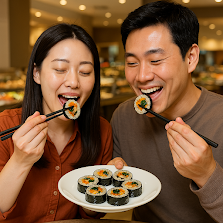Since ancient times, names have been considered important factors influencing a person’s fate and future beyond mere identification symbols in Eastern culture.
A name, the first gift a child receives when he or she is born, contains the parents’ earnest wishes and philosophy, and is sometimes carefully created with the belief that it complements the individual’s lacking energy or instills positive energy.
Even in modern society, this traditional naming method has continued in various forms without losing its meaning.
1 History and background of onomastics: Long-standing wisdom connecting life and destiny
Our lives have been deeply connected to fortune telling since ancient times.
From the naming that begins with the birth of a child to the selection of a grave that decorates the last moments of life, it has been a universal belief in the three countries of the East that goes beyond Confucianism or Buddhism.
Although the frequency has decreased compared to the past, many people still try to gauge the direction of their lives through fortune telling or a New Year’s fortune-telling approach when faced with difficult times or before a new beginning.
Against this backdrop, onomastics has developed as part of efforts to analyze an individual's fate and lead them in a better direction.
In particular, attempts to change one's fortunes by changing one's name when things do not go as planned are clear examples of the influence of onomastics on real life.
2 Name, the most basic way to express myself
A name is a unique means of distinguishing oneself from others and is the first step toward social life.
Changing one's name requires careful decision and should not be approached simply by following trends or with light thoughts.
It is an issue that should be seriously considered only when the positive effects of changing one's name are judged to be greater than the difficulties experienced due to the existing name.
Changing one's name can bring psychological stability and help one avoid unnecessary teasing or negative views from outside.
Traditionally, when naming or changing one's name, the five elements of sound, five elements of sound, and five elements of water are often considered.
However, the key is to comprehensively analyze the individual's current situation and fortune, rather than simply being caught up in these formal elements, and choose the most suitable name by comprehensively analyzing the individual's fortune.
Recently, as the name change process has been simplified, there is a tendency to think of changing names easily, but since names have a great impact on an individual's life, a careful approach is necessary.
The same goes for naming children when they are born.
Rather than simply following a pretty name or a family name, you should closely analyze the child's fortune and consider a name that can fill in the gaps and breathe in harmonious energy.
3 Specialness that Only Humans Have: Being Called by Name
Professor Park Je-wan mentioned the possession of 'Hwanhondonggak (喚魂同覺)' as a difference between humans and animals.
This refers to the special ability of humans to be recognized as social beings through their names, which is the ability for people around them to recognize them as independent entities and call them by their names.
Some animals, such as dogs and cows, are given names, but this is for the convenience of humans, and only humans recognize them as complete entities and call them by their names.
Such important names are usually created by people around them, such as parents or grandparents, taking into account various situations.
The most important thing at this time is to accurately understand the person's fortune and carefully name them based on the results.
Questions still exist about the origin and effectiveness of traditional naming methods that consider sounds, numbers, and the three elements and five elements.
There are also claims that it is difficult to find a clear verification process on where concepts such as the 28 constellations and the 12 horoscopes came from and how they can predict and discuss human fortunes and misfortunes.
4 Sajupalja: The only code given to the world
Sajupalja is like a unique code that contains the cosmic energy of a living being at the moment it is born.
This does not change until death and is deeply involved in an individual's personality, talent, destiny, etc. Therefore, when naming, it is a reasonable approach to analyze Sajupalja to balance the five elements and supplement the lacking energy.
In addition, it is important to carefully check whether the Chinese character meaning of the name has a positive and good meaning and whether there are any elements that could be made fun of.
5 Naming Foreigners: Another Perspective
The last issue to consider is the impression and naming of foreigners' names.
We need to have an in-depth discussion on how to interpret and apply the names of foreigners with different cultural and linguistic backgrounds from the perspective of Eastern onomastics.
This is another homework that we will have to solve in the future.
In conclusion,
In Eastern thought, naming is an important act that goes beyond simply naming a name and has a profound impact on an individual's life and destiny.
Based on traditional wisdom and modern understanding, naming a name by comprehensively considering the individual's fortune and circumstances is a wise way to maximize the positive meaning and energy contained in the name.








.jfif)













.jfif)






